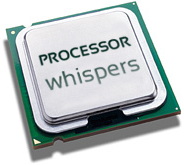by Andreas Stiller
 2011 has gotten off to a turbulent start: Intel presents a great new processor with integrated graphics, but is still regarded as the big loser of the Consumer Electronics Show by many market observers. Microsoft doesn’t fare any better as the company is slowly going into panic mode and now wants to jump on the ARM train. Over at AMD boss Dirk Meyer throws in the towel.
2011 has gotten off to a turbulent start: Intel presents a great new processor with integrated graphics, but is still regarded as the big loser of the Consumer Electronics Show by many market observers. Microsoft doesn’t fare any better as the company is slowly going into panic mode and now wants to jump on the ARM train. Over at AMD boss Dirk Meyer throws in the towel.
Apparently, AMD’s Board of Directors doesn’t trust the technician Meyer, who once lifted AMD to the technological summit with the design of the Athlon processor, to deal with the economic difficulties that the processor company is currently facing. Although, after the departure of Hector Ruiz he completely restructured the company and branched off the semiconductor production to Globalfoundries with massive Arabian support, he is being held responsible for bugs and long delays regarding important processors (Barcelona, Bulldozer...), missing out on the netbook and tablet hypes and the maybe unwise abandonment of the smartphone and TV chip market (selling the Ex-ATI branches Imageon and Xilleon to Qualcomm and Broadcom respectively). Now, a yet-to-be-appointed new CEO and president is supposed to take advantage of “the opportunity to create increased shareholder value“. Interim CEO Thomas Seifert, who has been the CFO for AMD’s finances since 2009, is neither expected, nor wishes, to remain in the job – after all, the German company he previously worked for as CFO and COO, Qimonda, didn’t cover itself with glory in this respect. Maybe long-time Microsoft manager Bob Muglia is a possible candidate. He has
Dirk Meyer (Ex-AMD, left) and Bob Muglia (still at Microsoft, right), both in their prime (early 50s) – where will they turn up? ![]()
Source: Microsoft & AMDannounced that he will be leaving Microsoft at the same time as Meyer leaves AMD. After Steve Ballmer and following the retirement of the legendary software architect Ray Ozzie in October 2010, Muglia is probably the most influential manager at Redmond. On the management team, he participates in all important economic and technology decisions and as the boss of the server and tools sector (Windows Server, SQL Server, Visual Studio, System Center, Windows Azure Platform, Cloud Computing), he is responsible for one of the company’s most profitable sources of income. Perhaps he was in disagreement with the boss concerning Silverlight and HTML5 or, maybe, he didn’t want to support the ARMing of Microsoft announced by Ballmer – in that case, he can’t go wrong with AMD.
Microsoft gets ARMed
In any case, at the Consumer Electronics Show (CES), Ballmer seriously affronted Microsoft’s old spouse Intel with his new found love for ARM and its whole extended family (NVIDIA, Qualcomm, Texas Instruments...) He didn’t actually say a word about Intel’s Atom processor Oak Trail, which had been especially upgraded for Windows. And although Intel had announced that the processor was in volume production last October, there was hardly anything to be seen of it at CES: a few unspectacular prototypes – that was all.
A meaningful comment by Otellini: “What I'm excited about is that Windows 8 will also support Intel down into the other devices. Today we don't have an opportunity to sell into Microsoft-based phones and Microsoft-based tablets”.Honi soit qui mal y pense. And what’s the big deal about “tablets and phones”? Sure, with Windows 8, Intel will get a much better access to gadgets than with Moblin or MeeGo. On the other hand, however, this way Microsoft is opening the gates to the sacred x86 markets for the ARMy.
Fusion in a quite different way
Actually, Intel’s Sandy Bridge and AMD’s Fusion were meant to pull the rug from under NVIDIA with their integrated graphics, at least in the markets for low-end and medium graphics. But NVIDIA's charismatic CEO Jen-Hsun Huang has artfully countered the attack with proprietary processors. NVIDIA’s Tegra 2, the first dual-core of the ARM Cortex A9 family, is ready and is being used in tablets and smartphones, among other devices, from Dell, Motorola, LG and Toshiba. Ironically, at the previous CES, LG still presented itself as an Intel partner with plans for a smartphone with the Moorestown processor.
According to Huan, Tegra is only the beginning though, as NVIDIA – well prepared with Android and the upcoming Windows 8 – now plans a long march toward the notebooks, desktop PCs and servers: “Project Denver”, that’s the name of NVIDIA’s roadmap for the development of the adequately capable CPUs based on the ARM instruction set. However much Intel’s vice president Dadi Perlmutter mocks NVIDIA for saying, until a short while ago, that CPUs are completely irrelevant – now, NVIDIA is producing CPUs themselves. And Intel even helps out financially: according to the agreement in the smoldering patent conflict about chip-sets, Intel will pay NVIDIA a total of $1.5 billion over the course of the next six years. In return, Intel may use all NVIDIA patents, which should be quite interesting for Intel’s graphics branch in Folsom.
On the other hand, this patent exchange agreement is of restricted validity as NVIDIA may not produce x86 processors nor use Intel’s NAND flash technology. NVIDIA can still manufacture chip-sets for Intel CPUs, but, according to Jen-Hsun Huang, isn’t interested in doing so. However, he hinted at a closer cooperation with Intel concerning GPU cores; Intel just buys the PowerVR graphics of the Atom Z500 and Z600 anyway.
With Tegra, NVIDIA is even winning ground in traditional ARM markets, especially those in which graphics play an important role, such as the automobile sector. Intel is also trying to get into this market and has been able to achieve some initial successes with its Atom, for instance with partner BMW. But guess just who NVIDIA has enticed away? Well, BMW’s navigation and vehicle control system iDrive will rely on the Tegra in the future – as well as Tesla Motors, while Audi already became a client a while ago. It should be an interesting race.
No comments:
Post a Comment